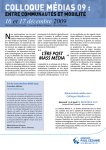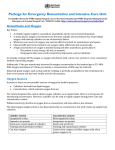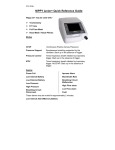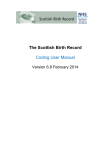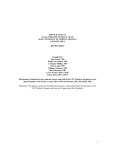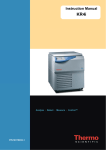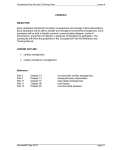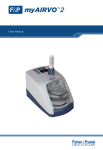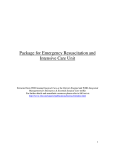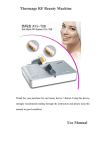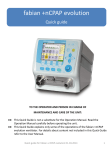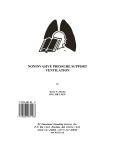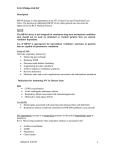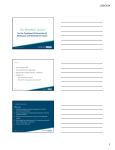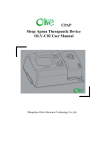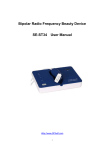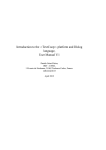Download PAEDIATRIC CRITICAL CARE NETWORK
Transcript
PAEDIATRIC CRITICAL CARE NETWORK Nasal Continuous Positive Airway Pressure (NCPAP) for the Acutely Ill Infant RESOURCE PACKAGE Hospital site………………………………………………………………………………………………………………………………………………. Authors: M Augey, V Brown, L Clancy, L Daniel, S Jefferson, M Milner. Owner: PCC Network Date of issue: September 2007 Review date: September 2009 CONTENTS Introduction 3 Statement of intent 3 Aim and objectives 3 Domain 1: Preparing self, infant and family Preparation of self Preparation of infant and family Gaining consent 4 4 5 5 Domain 2: Preparation of equipment, application and delivery of CPAP to the infant What is CPAP? Advantages of nasal CPAP Indications for use of CPAP Potential problems caused by CPAP therapy Equipment requirements Sizing and fixation Fixation and sizing techniques Troubleshooting alarms 6 6 6 7 7 8 8 9 11 Domain 3: Monitoring and care of the infant receiving CPAP Monitoring and observations Escalation of management Nursing implications Discontinuation/weaning from CPAP 13 13 14 16 19 References 21 Appendices: Organisation and provision of care Diagrams of nCPAP delivery systems Exercise 1 Exercise 2 22 23 27 28 2 INTRODUCTION The training package consists of the following elements: • A study period, including both theoretical and practical teaching. • Resource package. The evidence base for this resource is taken from current literature available on this subject. Recommendations made without strong evidence were formed by expert opinion and are thought to reflect good practice. • A period of supervised practice. • Exercises both in practical and theoretical aspects. STATEMENT OF INTENT The purpose of practitioners developing skills in the application and delivery of care to an infant requiring CPAP is in order to: Ensure infants with the potential to become critically ill receive a safe, effective and efficient level of care as determined and initiated by a practitioner with recognised knowledge and skills in the application, monitoring, and delivery of CPAP. Practitioners who have received training and supervised practice in these procedures may perform the correct methods for sizing, applying and delivering care to an infant requiring CPAP. AIM AND OBJECTIVES Our aim is to provide you with the theoretical knowledge, skills and understanding essential for performing the safe application, monitoring and delivery of care to infants receiving CPAP. This resource has been designed to include KSF (Agenda for Change, DOH, 1999) and is laid out in the core domains related to care of the infant and their family. The core domains are: 1. Preparing self, infant and family. 2. Preparation of equipment, application and delivery of CPAP to the infant. 3. Monitoring and care of the infant receiving CPAP. Each section introduces the learning outcomes, then covers the relevant theoretical and practical content required. 3 DOMAIN 1: Preparing self, child and family Learning outcomes • To understand the necessary competencies required for the application and delivery of CPAP to an infant. • To ensure the infant and family are prepared wherever possible and understand the implications of CPAP. Preparation of self The management of an infant on CPAP should be undertaken by a practitioner who accepts accountability for their actions and who feels competent to undertake the procedures required. In line with the NMC (2002) Code of Professional Conduct practitioners must exercise professional responsibility and practice within the code’s framework. It is important for all those caring for the infant receiving CPAP to fully understand the care required. This will help to ensure that successful, effective and safe treatment is administered. The ICU/NICU/HDU is viewed as the most appropriate environment to monitor and cared for infants requiring CPAP effectively. However should such infants be required to be care for within a designated ward area, full consultation should occur between the nursing and medical staff involved with the child’s care (as per local policy). The nursing staff are expected to be responsible for the setting up and ongoing care of the infant on CPAP, wherever the location. NB: Extreme caution must be exercised when caring for such patients on general wards as these infants require very close supervision and staffing levels should reflect this. Infants nursed on CPAP in a side room will require ‘specialling’ on a 1: 1 basis (appendix: provision of care) In line with guidelines laid down by the NMC on standards for records and record keeping, there must be an appropriate plan of care for infants receiving CPAP. The plan must be documented in the case notes by the medical staff including any parameters set. The plan must incorporate ongoing evaluation and reassessment of care and evidence that relevant interventions and observations have been communicated to appropriate members of the multi-disciplinary team. Any prescription changes should be recorded in the medical and nursing notes. 4 Preparation of infant and family Any practitioner working with children and young people must be able to communicate effectively. Communication can be verbal, non verbal and abstract, you may need to use more than one of these techniques when communicating with the child and family. Listening is a key element of effective communication. To engage in active listening you should take note of all aspects of the conversation and any gestures or expressions that suggest an underlying message or anxiety. A simple explanation to the parents regarding how the CPAP system supports their babies breathing will help them to understand the role of the therapy and their infant’s behaviour. The administration of CPAP does not interfere with parental contact or holding/handling the baby so parents will be able to care for their child during this period. If transferring the infant from the cot to the parent's arms ensure that the circuit is supported and continues to be positioned correctly. Ensure the family is involved in the care of their infant, update regularly on progress and treatment and promote attachment, especially in the neonatal age group. Provide continual reassurance for the infant and/or parents/carers, explaining all procedures. Gaining consent Any informed and competent person can authorise a medical procedure once the implications, hazards and alternatives have been appropriately explained. 5 DOMAIN 2: Preparation of equipment, application and delivery of CPAP Learning Outcomes • Discuss the concept of CPAP stating the indications for its use. • Correctly prepare equipment required when caring for an infant on CPAP. • Demonstrate the correct methods for sizing and applying the infant flow circuit for the delivery of NCPAP to an infant. • Set and troubleshoot any alarms with the system. What is CPAP? Continuous positive airway pressure (CPAP) is the application of positive pressure to the airways of the spontaneously breathing child throughout the respiratory cycle. For the most part, neonates are preferential nose breathers, which easily facilitates the application of nasal CPAP. This is accomplished by inserting nasal prongs (NCPAP), or infant nasal mask (NMCPAP) to the infant using a commercially available circuit in conjunction with a continuous gas flow source. The device provides heated and humidified continuous or variable flow from a circuit connected to a continuous gas source, via an infant flow driver, bubble CPAP system or mechanical ventilator, set in the CPAP mode. CPAP maintains inspiratory and expiratory pressures above atmospheric pressure, which results in an increase in functional residual capacity (FRC) and improvement in static lung compliance and decreased airway resistance in the infant with unstable lung mechanics. This allows a greater volume change per unit of pressure change (i.e., greater tidal volume for a given pressure change) with subsequent reduction in the work of breathing and stabilisation of minute ventilation (VE). CPAP increases mean airway pressure, and the associated increase in FRC should improve ventilation-perfusion relationships and potentially reduce oxygen requirements. Additionally CPAP may expand, or stent, upper airway structures preventing collapse and upper airway obstruction. Advantages of Nasal CPAP • Increases functional residual capacity (FRC) • Maintains lung volume • Improves lung compliance 6 • • • • • Reduces work of breathing Non-invasive procedure Allows development of small airways and promotes use of natural surfactant Easy to apply Cost effective Indications for use of CPAP • Abnormalities on physical examination-the presence of increased work of breathing as indicated by an increase in respiratory rate of normal, intercostal and substernal recession, grunting, and nasal flaring; the presence of pale skin colour and restlessness. • Inadequate arterial/capillary blood gas values indicating moderate respiratory failure ie hypercapnea. • Increased oxygen requirements to maintain a SaO2 greater than 92% with FiO2 >60% Potential problems caused by CPAP therapy Applications of CPAP are not benign procedures, and operators should be aware of the possible hazards and complications and take all necessary precautions to ensure safe and effective application. • Mouth breathing may result in loss of desired pressure and decrease in delivered oxygen concentration. • NCPAP harnesses and attachment devices are often cumbersome and difficult to secure and may cause agitation and result in inadvertent decannulation. • Increased intrathoracic pressure which causes reduced venous return which may lower cardiac output. • Barotrauma leading to surgical emphysema / pneumothoraces. • Sudden deterioration requiring immediate ventilation. • Aspiration. • Patient discomfort / intolerance of prongs/mask. • Facial sores. • Reduced ability to eat and drink. • Dry mouth and airways. • Stomach inflation with air. • Increased blood level of carbon dioxide due to an increase in dead space caused by the mask and tubing. 7 Equipment Requirements • Commercially available nasal prongs, or specially designed nasal masks with accompanying bonnet / harness and accessories may be used for CPAP administration. • Continuous flow air-oxygen gas source; commercially available bubble CPAP systems, CPAP flow driver system, or multipurpose ventilator with CPAP mode and integrated or adjunct low and high airway pressure alarms, oxygen concentration analyser with low and high alarms, loss of power and gas source alarms. • Lightweight CPAP or ventilator circuits with servo-regulated humidification system • Continuous noninvasive oxygenation monitoring by pulse oximetry or transcutaneous monitor with high and low alarm capabilities is recommended (continuous transcutaneous CO2 monitoring may also be utilised). • Continuous electrocardiographic (ECG) and respiratory rate monitor, with high and low alarm capabilities, is recommended. • Suction source, suction regulator, and suction catheters for periodic suctioning to assure patency of nasal passages and of endotracheal tubes used for NP-CPAP are necessary. • Resuscitation apparatus: adjunct, self inflating bag –valve mask device with reservoir bag and masks of appropriate size should be available. • Gastric tube for periodic decompression of stomach and chest tubes should be available. Sizing and Fixation Two types of patient interfaces that can be used to deliver NCPAP • Nasal prong • Nasal mask Both types of interface are made of soft silicone the principle is to provide a good seal within or around the infant’s nose so that the level of CPAP required can be generated and maintained. The size of the infant’s nares does not depend upon the infant’s weight, gestational age or length of the infant. The size of the nares is individual to that infant. To cater for these differences there are several sizes of nasal prongs and nasal masks available. 8 There are three sizes of nasal prongs: Small (ID 3.75mm) Medium (ID 4.25 mm) Large (ID 5mm) and these come packaged with the CPAP generator. CPAP prongs are designed for single use only. Prongs should not be used if the packet is open or damaged. The masks are available in extra small and extra large size only. The extra small is smaller than the small nasal prongs and the larger being bigger than the large nasal prongs. Fixation and Sizing Techniques 1. Select the correct size of prong or mask by using the nose guide provided. Insert the prong/mask into the generator. Always select the largest prong size that will fit comfortably into the infant’s nares, when prongs are too small there is a temptation to pull the generator too tightly to maintain the seal. The seal is created by the gas flow causing the soft silicon to mould to the babies’ nares. 2. Measure the head with the colour-coded tape, selecting the appropriate sized bonnet using the bonnet guide. The infants head is not determined by its weight, length or gestation necessarily but rather by the size of the head circumference. 3. Fix the generator onto the bonnet by placing the generator on top of the bonnet above the central Velcro tie. Loosely weave the Generator straps through the buttonholes starting inside the bonnet with the LOWEST coloured buttonhole. Do not over-tighten the threads or use tape to fix in place as this will delay removal of the generator if the infant deteriorates. 9 4. Apply NCPAP therapy by supporting the generator on the bonnet. Gently place the bonnet onto the infant’s head checking that the ears are in a normal position. Pull the bonnet well down over the infant’s ears. 5. Lift the Generator from the top of the bonnet and bring towards the infant’s nose. Gently insert the prongs or mask into position to create a seal and deliver NCPAP. Support the generator whilst securing all three tubes using the central Velcro tie. Take the generator straps horizontally across the infant’s cheeks and secure, but do not over tighten. 6. Split the inspiratory and pressure lines and secure with secondary Velcro ties. Tie off the open end of the bonnet. 7. Final check (visual observations) • Bonnet well down over the infant’s head • • • • • • • Ears well covered and flat against head Nose in normal position not squashed or pulled upwards. Eyes clearly visible Inspiratory and pressure lines attached to bonnet Exhalation line left free Generator is stable and secure Infant is receiving required level of CPAP 8. Hourly assessment as above. Every 3-4 hours loosen the generator straps and tubing from the central Velcro tie, move the generator away from the infant’s face and inspect the skin and nasal tissue. Reapply the generator from step 5. CPAP is initiated at levels of 4 cm H2O and an FiO2 0.6. If SpO2 > 95% reduce FiO2 to keep SpO2 92 – 95%. If SpO2 < 92% adjust FiO2 to keep SpO2 92 – 95% (maximum FiO2 of 80%). 10 If FiO2 > 0.6 increase CPAP by 2cmH2O up to 8 cmH2O. If SpO2 remains < 92% - Consider efficacy of CPAP, X- ray, consider ventilation. Once the Generator has been applied it is important to ensure that the circuit tubing is also positioned correctly i.e. around the back of the infant’s head. Do not secure the circuit tubing too rigidly. Remember to allow for the infant’s movement. Ensure the circuit tubing does not cause any drag on the infant’s head or nose. Note • • • • • Prong/Mask too small = difficulty forming a seal and allows leak to occur; low CPAP alarm sounds; difficulty providing the required level of CPAP. Prongs too large= uncomfortable for the infant and may cause trauma to nares. Mask too large = overlap the infants mouth or sits too close to the infants eyes. Bonnet too small = causes discomfort and may put pressure on the head Bonnet too large = sits incorrectly on the head; slips forward into the infants eyes Troubleshooting Alarms Gas failure alarm Supply failure of gas source to generator. Check both air and oxygen hoses are correctly inserted into gas source High or low oxygen level alarms Incorrect setting of alarm limits during set up period Failure to reset alarms after any adjustments to Fi O2 delivery. Note alarms set at 5% above and below oxygen level Driver needs calibration High pressure level alarms Check infant is settled and comfortable Check flow rate and for any signs of occlusion within the circuit Incorrect setting of alarm limits during set up period Failure to reset alarms after adjustments made to level of CPAP delivered 11 Note alarms set 3 cmH2O above set pressure Low pressure level alarms Check infant and flow rate, ensure prongs are patent i.e. no evidence of leak in circuit or dislodged prongs with ineffective seal Incorrect setting of alarm limits during set up period Failure to reset alarms after adjustments made to level of CPAP delivered Note alarms set 2 cmH2O below set pressure Not achieving desired level of CPAP for flow rate i.e. Leak alarm Inadequate seal by mask or prong Leak from circuit – check connections especially temperature prone site Infant has an open mouth 12 DOMAIN 3: Monitoring and ongoing care of the infant receiving NCPAP Learning Outcomes • Stipulate the observations and nursing care required when caring for an infant on CPAP. • Demonstrates knowledge of the potential problems that may occur when managing an infant on CPAP. • Discuss the indications for either weaning from or escalation of CPAP. Monitoring and observations The sick infant’s condition may rapidly deteriorate therefore, review all patients within half an hour of establishing CPAP and subsequently half hourly for the first four hours. Careful documentation of all observations is required, it is usual after the first four hours to record these hourly. Routine assessment and observation include the following:Information obtained from the Flow Driver and Humidifier • CPAP level administered. • The percentage of oxygen delivered (FiO2). • Temperature reading on heated humidifier. • Flow rate. Physiological observations • Respiration rate, depth and rhythm (consider trend). • Oxygen saturation levels note episodes of de-saturation and increases in oxygen requirements. • Heart rate and rhythm. • Capillary refill time • Skin colour. • The infant’s behaviour and conscious levels. • The condition of the skin around the nasal area. • Blood gas values. • Transcutaneous oxygen and carbon dioxide levels if available. • Blood pressure reading (as a baseline reading may be useful). 13 Arterial/capillary Blood gas sampling. Blood gas sampling and analysis will usually be performed in relation to the infant’s clinical condition, as dictated by a clinician. In infant’s capillary samples are usually relatively easy to obtain, however if multiple sampling is required consideration may be given to the placement of an indwelling arterial catheter. Specimens of blood only reflect the physiological condition at the moment of sampling (e.g. pain from the puncture itself may lead to hyperventilation with consequent changes in values). Blood gas analysis provides a good indication over time of an infant’s improving or worsening condition. Other blood testing may be requested at the direction of the clinician dependent upon the infant’s overall condition. CXR Chest radiographs may be requested by the clinician to gain further information regarding the infant’s lung condition, and to assess for any deterioration or improvement. By utilizing all of the above information the clinician, nurse and other members of the multidisciplinary team will be able to provide an individualized plan of care for each patient. Medical Review As the decision is made to place an infant onto NCPAP it is important for the children’s ward area initiating treatment to notify the local PICU to inform them of the increased dependency of the infant. It is important to have a frequently reviewed medical management plan for each child. It may be useful to include some physiological parameters, and some guidance to direct nursing and medical staff in the event of the child not meeting these parameters. If the clinical condition has deteriorated in the first half hour the team may need to consider an anaesthetic review with possible intubation of the infant and transfer to the intensive care unit as per local policy. If there are no further signs of deterioration continue to monitor the infant and review blood gases 4 - 8 hourly Escalation of Management Indications for escalation of management to intubation and ventilation are based upon signs of increased work of breathing and respiratory failure (see PCC Guideline: Management of Bronchiolitis use of CPAP). 14 Vital to assess The effort of breathing Respiratory rate, depth and pattern of respirations. Increased effort may manifest itself as recession with use of accessory muscles, nasal flaring, tracheal tug, head bobbing, grunting and tachypnoea. The efficacy of breathing Noting effective symmetrical chest expansion with equal air entry, evidence of abdominal excursion, desaturation demonstrating increased oxygen requirements. The effects upon other physiology Physiological effects upon heart rate, capillary refill time, skin colour, mental status / activity. Cardinal Signs Restlessness / irritability Tachypnoea Tachycardia Apnoea Desaturation Unresolved hypercarbia and increased oxygen requirements will manifest themselves as a respiratory acidosis on blood gas analysis Preterminal Signs Exhaustion Respiratory depression Bradycardia The following equipment must be immediately available: • • • • • • Emergency/crash trolley. Bag-Valve-Mask device with reservoir bag and appropriately sized mask. Monitoring-ECG, oxygen saturation’s, blood pressure. Suction and yankaeur sucker &/or appropriate size suction catheters. Additional oxygen supply. Ventilator. 15 Nursing Implications Infection Control If the child is considered to have an infectious condition normal hospital trust infection control policy should prevail. This usually entails barrier nursing the child in an individual cubicle. The Flow Driver circuit and humidifier chamber should be changed every seven days or as per local infection control policy. The circuit and chamber may be renewed sooner if it is visibly dirty. Between patients the exterior of the Flow Driver machine should be cleaned with a disinfection wipe or soapy damp cloth. Humidification and Suctioning The normal function of the nose and air passages of the respiratory tract is to warm, moisten and filter the inhaled gases before it reaches the lungs. Therefore, the aim is to provide gases that imitate the work of the nose, i.e. to warm the gases to body temperature (37 ˚C) and to provide humidity so the mucus lining of the airways do not become dry, causing the formation of thickened secretions and mucus plugs. The warm water humidification systems generally used is the Fisher and Paykel system (set 37 -2). When using the heated humidification system care must be taken to ensure the chamber has the adequate supply of sterile water present thus avoiding the system to overheat. Care should also be taken to ensure the tubes from the humidifier to the child are free from water as this may impede the gas flow to the patient and potentially cause deterioration in the infant’s condition. If this occurs simply lift tubing and drain the water back into the humidifier as necessary. The use of cold water humidification systems is no longer advocated as this has been shown to be ineffective. Suctioning of the oro and naso-pharynx is a procedure which infants requiring respiratory support may require. This is carried out to prevent the endotracheal and nasal prongs becoming blocked with secretions. However, it is important to remember that NCPAP is a non-invasive technique; therefore, suctioning should only be performed according to clinical need. Over vigorous suctioning can lead to • Mucous lining irritation • Increased tissue damage with greater secretion production • Vasovagal responses (bradycardia) 16 Feeding / Fluid Management For the first 24-48 hours of CPAP it is important to stop oral feeds and give IV fluids (sodium chloride 0.45% glucose 5% with potassium supplementation) which may be restricted. An oro-gastric tube (OGT) or naso-gastric tube (NGT) will be required to prevent gastric distension and splinting of the diaphragm, which occurs when the infant swallows air, it may be advantageous to leave this tube on free drainage and/or to aspirate it four hourly if the infant is nil by mouth. When a NGT is used careful assessment of CPAP level is essential as this tube may impede fixation of the nasal prongs and reduce the efficiency of the generator. If fixation is a problem an OGT should be passed. Nasal CPAP is not a contraindication to enteral feeding; however the clinician and nurse will need to assess each individual infant accordingly when introducing feeding, devising a regime depending upon the infant’s ability to tolerate enteral feeds. The use of a dummy during feeds may be advantageous and has been reported to decrease heart rate and reduce energy expenditure. Mouth Care The mouth becomes very dry due to the high gas flow and mouth care should be performed regularly. Dummy’s help create a better seal for the CPAP and also encourage non-nutritive sucking in the pre-term or tiny infant. Pressure Area Care The position of the nose and prongs should be checked hourly to check the nose position is normal (not squashed or pulled up). The prongs must be released from the nares every 4 hours, to release the pressure, inspect the nose and nasal tissues for necrosis. Ensure the skin around the nasal area is kept clean and dry. Do not apply creams or ointments to the nasal area. If the prongs/masks become contaminated they may be cleansed with hot soapy water, rinsed and dried carefully. It is not uncommon to see that the infant’s nares have taken on a more rounded appearance when the prongs have been in situ-this is a temporary change only. Also it may be necessary to upgrade the nasal prongs using the nose guide as an assessment tool. The CPAP mask must be firmly and evenly applied around the nasal area to form a comfortable fit to create and maintain the desired CPAP level. The straps and mask may rub especially over bony prominence such as bridge of the nose, ears and back of the head. Observe the pressure point from the masks prongs or straps. Use Granuflex or similar for padding to minimise friction and treat pressure sores. 17 On a daily basis as part of the infants care plan any deterioration in skin integrity around the nose should be documented, along with the bonnet size, prong/mask size in use and their date of change with a date, time and signature. As well as the particular pressure area advice regarding the CPAP Flow Driver, care should be taken to assess and evaluate all of the infant’s pressure areas. Because the child may be particularly comfortable and achieving the desired CPAP, routine pressure area care at times may become a lower priority, particularly as moving the child may disturb them and settling them again may take some time. However, it is important to ensure pressure damage does not occur. The nurse caring for the child needs to be aware of the potential for the infant to develop pressure damage and the plan of care should reflect this. The child’s position should be changed as their condition allows, paying particular attention to the ears, head, heels, sacrum and bony prominences. If the child is considered too sick for changes in position the nurse must document this in the nursing care plan. Pressure relieving aids are available i.e. gel pads and should be utilized as per local trust guidelines. Handling/Positioning Positioning of the infant is an issue for careful consideration and as with fixation will optimise comfort and enhance results. The administration of NCPAP therapy and the use of the Infant flow driver do not interfere with the positioning of the infant. The infant can be positioned in the prone lateral, or supine position-the former two are most commonly adopted. The position selected will be determined by many factors other than the use of NCPAP. Appropriate positioning helps to ensure that the infant maintains a clear airway and promotes comfort. Further it has been shown that that positioning is important in terms of the infant’s neurological development. The infant will require as near foetal-like flexion as possible, thus maximising skeleto-muscular development and is achieved with nesting around the baby, particularly hips and shoulders. If flexion of the infant’s head and neck is too pronounced the airway is compromised, but this can be resolved by gentle extension. The use of positioning aids may be considered as appropriate, with regular observation and evaluation of pressure areas. Infants on prolonged NCPAP may benefit from some passive limb movements. Consider referral to physiotherapy as per local policy 18 If a baby is very active, optimal positioning for the delivery of NCPAP may be difficult but can usually be addressed. Factors such as hunger, restraint, cerebral oedema, over-handling, drug withdrawal and other environmental factors can lead to excessive spontaneous motor activity. Care should therefore be taken to alleviate such factors before concluding that the baby is not tolerating NCPAP. For example a dimly lit, peaceful and a quiet environment may help to settle a very active distressed infant. Try and co-ordinate cares together to minimise disturbance of the child and maintain therapeutic periods of CPAP as much as possible. Handling should be kept to a minimum to reduce the work of breathing. Comfort / Sedation Occasionally children may be difficult to settle on the CPAP Flow Driver becoming irritable, difficult to manage and therefore, potentially reducing the amount of CPAP they receive. It is important to consider why this may be. Assessment of the child is necessary to rule out any obvious reasons, i.e. uncomfortable position, ill-fitting prongs, sore nose, wet nappy and hunger. Rectifying these problems is often simple – the use of a dummy along with swaddling may settle the child and achieve the set CPAP. Soothing music and reducing the light may also be beneficial (if appropriate). Enteral paracetamol may be useful both as an anti-pyretic and analgesic. Occasionally none of the above may help and after careful consideration sedation may be indicated, usually in the form of chloral hydrate. The decision to give the child sedation should not be a routine one, indeed, it is rarely indicated, as the sedation itself may cause respiratory depression in the already sick child and could lead to a deterioration in the condition of the child. The decision to prescribe and give the child sedation should be made by the Consultant caring for the child. It may not be appropriate to give the child sedation and if the child remains intolerant of the NCPAP then alternative treatment, such as invasive ventilation, may need to be initiated. Discontinuation / Weaning from NCPAP The process of weaning may begin when recovery is evident. This is usually based on the following criteria. • The general physiological condition is stable. • FiO2 requirements are minimal. • CPAP levels are minimal. • Blood gas values are within normal or acceptable limits. 19 The infant can be weaned off CPAP for a period of a few hours at a time to slowly reduce down support; however as the infants condition improves often they will not tolerate the equipment and will force the decision to discontinue the treatment. Therapy may also be discontinued if it • The infant no longer tolerates the nasal prongs / mask. • Development of gastric complications and diaphragmatic splinting • Fails to accomplish the desired affects. o Need for IPPV o No progress at 72hours – discuss with PICU to review diagnosis / co-morbidity, consider ventilation 20 REFERENCES Blease J (1997) Step by Step Guide Nursing Care Issues in NCPAP Journal of Neonatal Nursing Volume 3, Issue 1 1997 (Insert) Chessex P et al (1981) Relation between heart rate and energy expenditure in the neonate, Paediatric Research 15: 1077-82 Department of Health (1997) Paediatric Intensive Care. “A framework for the Future” Department of Health Publications London. Department of Health (2001) High Dependency Care for Children. Department of Health Publications London. Department of Health (2004) The NHS Knowledge and Skills framework (NHS KSF) and the development review process. Department of Health Publications London. Department of Health (2004) National Service Framework for Children and Young People Department of Health Publications London EME Infant Flow System-Clinical Training Workbook EME Infant Flow System-Clinical Teaching Manual Goggin M (2001) Step by Step Guide Developments in NCPAP Fixation. JOURNAL OF Neonatal Nursing Volume 7, Issue 2 2001 (insert) Nursing and Midwifery Council (2002) Code of Professional Conduct NMC. London. Partners in Paediatrics (2006) Paediatric Guidelines 2006. Sherwin Rivers. Stokeon-Trent Place B (1997) Using Airway Pressure, Nursing Times 93 (31) July 30 42-44 Roman J, Donald F, (1995) Physiological effects of continuous positive airway pressure (CPAP) ventilation in the critically ill. Care of the Critically Ill 11 (6), 239243 Stocks J (1980) Effects of nasogastric Tubes on nasal resistance during infancy. Archives of Disease in Childhood, 55, 17-21. Thia LP, McKenzie SA, (2007) Randomised controlled trial of nasal continuous positive airway pressure (CPAP) in bronchiolitis. Archives Disease in Childhood. Published online: 7 March 2007. doi:10. 1136/adc.2005.091231 http://www.fphcare.com. http://www.sign.ac.uk/pdf/sign91.pdf 21 APPENDICES Organisation and Provision of Care When caring for an infant receiving nCPAP via the infant flow system it is important to consider the organisation and provision of care. By utilising the levels of care description and clinical categories recommended by the Department of Health12 nursing dependency, clinical context and numbers and nature of interventions are taken into account. From this any infant having recurrent apnoeas, or with bronchilolitis receiving a FiO2 > 0.6 via a head box, face mask or continuous positive pressure requires high dependency care. Level 1 Level 2 Level 3 Level 4 Classification of Paediatric Intensive Care Levels High-dependency care with nurse: patient ratio of 1:2 • A child who needs close monitoring and observation but not acute mechanical ventilatory support. • A child requiring long-term ventilatory support via a tracheostomy. Intensive care with nurse patient ratio 1:1 • A child who needs continuous nursing supervision. • A child who is intubated and receiving ventilatory support, including continuous positive airways pressure. • A child who has been recently extubated. • An unstable level 1 case. • A level 1 case who is being nursed in a cubicle. Intensive care with nurse:patient ratio of 1.5:1 • A level 2 case requiring multiple or complex interventions. • A level 2 case with multiple organ failure. • A level 2 case being nursed in a cubicle Intensive care with nurse :patient ratio of 2:1 Most level 2 care and all level 3 and 4 are provided in regional paediatric intensive care units but some Level 1 and 2 care will be provided in district general hospitals or major acute general hospitals 1 2 Department of Health (1997) Paediatric Intensive Care. “A framework for the Future” Department of Health (2001) High Dependency Care for Children The classification of the sick infant requiring CPAP is Level 1 (high dependency), however they may very rapidly move from one level to another. Consequently good communication should exist between district general hospital / major acute general hospital and Lead Centre clinicians to ensure all children receive the highest standards of care. Note: The level of care within a general paediatric ward should not exceed high dependency care with the exception of a period of stabilization prior to transfer 22 Diagrams of nCPAP delivery systems EME Infant Flow Systems Oxygen Concentration Display Air- Oxygen mixer control CPAP level Indicator Pressure Input Power Indicators Circuit Connection Alarm /Mute Flow Rate Indicator Adjustment Check the CPAP level indicator is indicating that the flow is providing the required support e.g a prescribed CPAP of 5cm should correlate to a reading of 5 on the gauge. If not check the circuit. 23 EME Infant Flow driver Mark II 24 Fisher Paykel Bubble CPAP 1. Pressure Manifold 2. MR290 Chamber – humidifier dome 3. Single –heated circuit 4. CPAP Generator Pressure Manifold CPAP Generator 25 The patient interface Head Gear Nasal tubing & prongs 26 Exercise 1 Defining, indications and principles of care 1. What is CPAP and when may it be used? 2. What are the potential problems of NCPAP? 3. List the vital signs that should be monitored during NCPAP therapy 4. What other observations should be performed and how often? 5. When caring for an infant on NCPAP list the specific aspects of ongoing care that need to be addressed? 27 Exercise 2 Preparation of equipment sizing and fixation Essential criteria Demonstrates appropriate equipment collection and stability of the generator and humidifier Demonstrates correct set up and use of device Performance Correct attachment of electrical supply, air and oxygen hoses. Knowledge and Understanding Has an awareness of health and safety issues relating to use of medical gases and electricity (see Trust policy on health and safety). Demonstrates correct connection of infant flow circuit, generator and humidifier. Understands the flow of gas through the driver to the infant and exhalation Demonstrates setting CPAP level to 4 -5 cmH2O Understands the relationship between set flow rate and delivered CPAP level Understands the importance Demonstrates setting oxygen level to 21, 50 100% of monitoring oxygen use in infants. Defines key safety responsibilities Demonstrates how to correctly apply the infant flow system using fixation technique described earlier (page 8) Demonstrates correct cleaning and storage after use Demonstrates setting and monitoring correct temperature and humidity Demonstrates how to set and reset alarm limits. Selects correct size of prong / mask for infant. Selects appropriate size of bonnet Correct application of the infant flow generator onto the baby Dismantles driver after patient use and cleans according to local policy and user manual 28 Understands implications and importance of humidified gases. Understands alarm system and how to troubleshoot and silence alarms. Understands the principles and importance of sizing and fixation techniques. Understands principles of infection control and safe storage




























